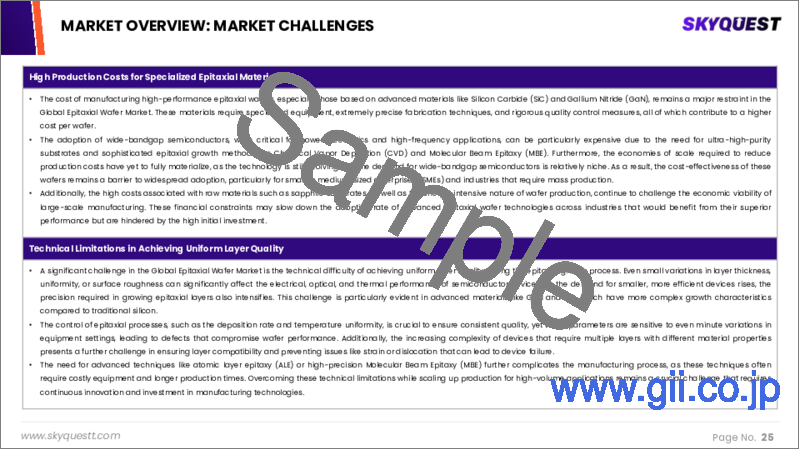|
|
市場調査レポート
商品コード
1647467
エピタキシャルウェハー市場規模、シェア、成長分析:タイプ別、ウェハーサイズ別、堆積法別、用途別、最終用途産業別、地域別 - 産業予測 2025年~2032年Epitaxial Wafer Market Size, Share, and Growth Analysis, By Type (Silicon-based Wafers, Gallium Arsenide Wafers), By Wafer Size (2-4 Inch, 5-8 Inch), By Deposition Method, By Application, By End-use Industry, By Region - Industry Forecast 2025-2032 |
||||||
|
|||||||
| エピタキシャルウェハー市場規模、シェア、成長分析:タイプ別、ウェハーサイズ別、堆積法別、用途別、最終用途産業別、地域別 - 産業予測 2025年~2032年 |
|
出版日: 2025年01月29日
発行: SkyQuest
ページ情報: 英文 157 Pages
納期: 3~5営業日
|
全表示
- 概要
- 目次
エピタキシャルウェハー市場規模は2023年に42億3,000万米ドルで、2024年の47億2,000万米ドルから2032年には113億6,000万米ドルに成長し、予測期間中(2025~2032年)のCAGRは11.6%で成長する見通しです。
エピタキシャルウェハーの需要は、電子移動度を高め、微小電気機械システム(MEMS)をサポートする能力によって、特に民生用電子機器において力強い成長を遂げています。この需要は、自律走行車や電気自動車の販売急増に伴い、様々なモニタリング・アプリケーションのための自動車分野での採用が増加していることによって、さらに拍車がかかっています。さらに、モノのインターネット(IoT)へのエピタキシャルウェハーの統合が大きな勢いをもたらしており、この分野の技術革新を促進しています。省エネとグリーン技術への世界のシフトも、産業界が持続可能なソリューションを求める中で需要を拡大しています。エネルギー効率の高いLED照明を推進する政府の取り組みが新たな機会を生み出し、エピタキシャルウェハー市場は複数の分野で大きく拡大するものと思われます。
目次
イントロダクション
- 調査の目的
- 調査範囲
- 定義
調査手法
- 情報調達
- 二次データと一次データの方法
- 市場規模予測
- 市場の前提条件と制限
エグゼクティブサマリー
- 世界市場の見通し
- 供給と需要の動向分析
- セグメント別機会分析
市場力学と見通し
- 市場概要
- 市場規模
- 市場力学
- 促進要因と機会
- 抑制要因と課題
- ポーターの分析
主な市場の考察
- 重要成功要因
- 競合の程度
- 主な投資機会
- 市場エコシステム
- 市場の魅力指数(2024年)
- PESTEL分析
- マクロ経済指標
- バリューチェーン分析
- 価格分析
- ケーススタディ
- 規制情勢
- 特許分析
エピタキシャルウェハー市場規模:タイプ別& CAGR(2025-2032)
- 市場概要
- シリコンベースのウェハー
- ガリウムヒ素ウェハー
- シリコンカーバイドウェハー
- 窒化ガリウムウェハー
エピタキシャルウェハー市場規模:ウェハーサイズ別& CAGR(2025-2032)
- 市場概要
- 2~4インチ
- 5~8インチ
- 9~12インチ
- その他
エピタキシャルウェハー市場規模:堆積法別& CAGR(2025-2032)
- 市場概要
- 気相エピタキシー
- 液相エピタキシー
- 分子線エピタキシー
エピタキシャルウェハー市場規模:用途別& CAGR(2025-2032)
- 市場概要
- LED
- パワー半導体
- MEMSベースのデバイス
- その他
エピタキシャルウェハー市場規模:最終用途産業別& CAGR(2025-2032)
- 市場概要
- 家電
- 自動車
- その他
エピタキシャルウェハー市場規模:地域別& CAGR(2025-2032)
- 北米
- 米国
- カナダ
- 欧州
- ドイツ
- スペイン
- フランス
- 英国
- イタリア
- その他欧州地域
- アジア太平洋地域
- 中国
- インド
- 日本
- 韓国
- その他アジア太平洋地域
- ラテンアメリカ
- ブラジル
- その他ラテンアメリカ地域
- 中東・アフリカ
- GCC諸国
- 南アフリカ
- その他中東・アフリカ
競合情報
- 上位5社の比較
- 主要企業の市場ポジショニング(2024年)
- 主な市場企業が採用した戦略
- 市場の最近の動向
- 企業の市場シェア分析(2024年)
- 主要企業の企業プロファイル
- 会社概要
- 製品ポートフォリオ分析
- セグメント別シェア分析
- 収益の前年比比較(2022-2024)
主要企業プロファイル
- IQE plc(UK)
- GlobalWafers Co., Ltd.(Taiwan)
- Nichia Corporation(Japan)
- Cree, Inc.(USA)
- Epistar Corporation(Taiwan)
- Siltronic AG(Germany)
- Sumco Corporation(Japan)
- II-VI Incorporated(USA)
- Soitec(France)
- Shin-Etsu Chemical Co., Ltd.(Japan)
- Wafer Works Corporation(Taiwan)
- AXT, Inc.(USA)
- STMicroelectronics N.V.(Switzerland)
- ON Semiconductor Corporation(USA)
- NXP Semiconductors N.V.(Netherlands)
- Tower Semiconductor Ltd.(Israel)
- Advanced Micro Devices, Inc.(USA)
- Texas Instruments Incorporated(USA)
- Samsung Electronics Co., Ltd.(South Korea)
- TSMC(Taiwan Semiconductor Manufacturing Company)(Taiwan)
結論と推奨事項
Epitaxial Wafer Market size was valued at USD 4.23 billion in 2023 and is poised to grow from USD 4.72 billion in 2024 to USD 11.36 billion by 2032, growing at a CAGR of 11.6% during the forecast period (2025-2032).
The demand for epitaxial wafers is experiencing robust growth, particularly in consumer electronics, driven by their ability to enhance electron mobility and support micro-electromechanical systems (MEMS). This demand is further fueled by their rising adoption in the automotive sector for various monitoring applications, aligning with the surge in sales of autonomous vehicles and electric cars. Additionally, the integration of epitaxial wafers into the Internet of Things (IoT) is providing significant momentum, facilitating innovation in this area. A global shift toward energy conservation and green technologies is also amplifying demand, as industries seek sustainable solutions. Government initiatives promoting energy-efficient LED lighting are set to create new opportunities, positioning the epitaxial wafer market for significant expansion across multiple sectors.
Top-down and bottom-up approaches were used to estimate and validate the size of the Epitaxial Wafer market and to estimate the size of various other dependent submarkets. The research methodology used to estimate the market size includes the following details: The key players in the market were identified through secondary research, and their market shares in the respective regions were determined through primary and secondary research. This entire procedure includes the study of the annual and financial reports of the top market players and extensive interviews for key insights from industry leaders such as CEOs, VPs, directors, and marketing executives. All percentage shares split, and breakdowns were determined using secondary sources and verified through Primary sources. All possible parameters that affect the markets covered in this research study have been accounted for, viewed in extensive detail, verified through primary research, and analyzed to get the final quantitative and qualitative data.
Epitaxial Wafer Market Segments Analysis
Global Epitaxial Wafer Market is segmented by Type, Wafer Size, Deposition Method, Application, End-use Industry and region. Based on Type, the market is segmented into Silicon-based Wafers, Gallium Arsenide Wafers, Silicon Carbide Wafers and Gallium Nitride Wafers. Based on Wafer Size, the market is segmented into 2-4 Inch, 5-8 Inch, 9-12 Inch and Others. Based on Deposition Method, the market is segmented into Vapor Phase Epitaxy, Liquid Phase Epitaxy and Molecular Beam Epitaxy. Based on Application, the market is segmented into LED, Power Semiconductor, MEMS Based Devices and Others. Based on End-use Industry, the market is segmented into Consumer Electronics, Automotive and Others. Based on region, the market is segmented into North America, Europe, Asia Pacific, Latin America and Middle East & Africa.
Driver of the Epitaxial Wafer Market
The epitaxial wafer market is experiencing substantial growth driven by the increasing demand for advanced electronic devices such as smartphones, tablets, wearable technology, and Internet of Things (IoT) devices. These modern gadgets necessitate high-performance semiconductors, which rely on epitaxial wafers to ensure precision and efficiency in their manufacturing processes. As consumer preferences evolve towards smarter, faster, and more interconnected technology, the requirement for epitaxial wafers in the production of integrated circuits (ICs) is rapidly rising. This upward trend highlights the crucial role epitaxial wafers play in meeting the needs of an ever-evolving electronics landscape.
Restraints in the Epitaxial Wafer Market
The epitaxial wafer market faces a notable constraint due to the intricate and advanced equipment required for its production, resulting in considerable initial capital investments for manufacturers. This financial barrier can pose challenges, particularly for smaller businesses or emerging markets aiming to penetrate the industry. The substantial upfront expenses tied to establishing epitaxial wafer manufacturing facilities can hinder both market entry and growth opportunities. Consequently, these high costs may deter potential new entrants and limit the competitive landscape, ultimately impacting the overall development and dynamism of the epitaxial wafer market.
Market Trends of the Epitaxial Wafer Market
The epitaxial wafer market is witnessing a robust trend driven by rapid miniaturization and the evolution of advanced semiconductor technologies. As electronic devices shrink in size while increasing in power, the demand for high-precision epitaxial wafers is surging. This trend is closely tied to the expanding applications in key areas such as 5G technology, artificial intelligence (AI), the Internet of Things (IoT), and edge computing, all of which require compact, efficient semiconductor components for optimal performance. Consequently, manufacturers are innovating to enhance wafer quality and performance, positioning themselves to meet the evolving needs of this dynamic market.
Table of Contents
Introduction
- Objectives of the Study
- Scope of the Report
- Definitions
Research Methodology
- Information Procurement
- Secondary & Primary Data Methods
- Market Size Estimation
- Market Assumptions & Limitations
Executive Summary
- Global Market Outlook
- Supply & Demand Trend Analysis
- Segmental Opportunity Analysis
Market Dynamics & Outlook
- Market Overview
- Market Size
- Market Dynamics
- Drivers & Opportunities
- Restraints & Challenges
- Porters Analysis
- Competitive rivalry
- Threat of substitute
- Bargaining power of buyers
- Threat of new entrants
- Bargaining power of suppliers
Key Market Insights
- Key Success Factors
- Degree of Competition
- Top Investment Pockets
- Market Ecosystem
- Market Attractiveness Index, 2024
- PESTEL Analysis
- Macro-Economic Indicators
- Value Chain Analysis
- Pricing Analysis
- Case Studies
- Regulatory Landscape
- Patent Analysis
Global Epitaxial Wafer Market Size by Type & CAGR (2025-2032)
- Market Overview
- Silicon-based Wafers
- Gallium Arsenide Wafers
- Silicon Carbide Wafers
- Gallium Nitride Wafers
Global Epitaxial Wafer Market Size by Wafer Size & CAGR (2025-2032)
- Market Overview
- 2-4 Inch
- 5-8 Inch
- 9-12 Inch
- Others
Global Epitaxial Wafer Market Size by Deposition Method & CAGR (2025-2032)
- Market Overview
- Vapor Phase Epitaxy
- Liquid Phase Epitaxy
- Molecular Beam Epitaxy
Global Epitaxial Wafer Market Size by Application & CAGR (2025-2032)
- Market Overview
- LED
- Power Semiconductor
- MEMS Based Devices
- Others
Global Epitaxial Wafer Market Size by End-use Industry & CAGR (2025-2032)
- Market Overview
- Consumer Electronics
- Automotive
- Others
Global Epitaxial Wafer Market Size & CAGR (2025-2032)
- North America (Type, Wafer Size, Deposition Method, Application, End-use Industry)
- US
- Canada
- Europe (Type, Wafer Size, Deposition Method, Application, End-use Industry)
- Germany
- Spain
- France
- UK
- Italy
- Rest of Europe
- Asia Pacific (Type, Wafer Size, Deposition Method, Application, End-use Industry)
- China
- India
- Japan
- South Korea
- Rest of Asia-Pacific
- Latin America (Type, Wafer Size, Deposition Method, Application, End-use Industry)
- Brazil
- Rest of Latin America
- Middle East & Africa (Type, Wafer Size, Deposition Method, Application, End-use Industry)
- GCC Countries
- South Africa
- Rest of Middle East & Africa
Competitive Intelligence
- Top 5 Player Comparison
- Market Positioning of Key Players, 2024
- Strategies Adopted by Key Market Players
- Recent Developments in the Market
- Company Market Share Analysis, 2024
- Company Profiles of All Key Players
- Company Details
- Product Portfolio Analysis
- Company's Segmental Share Analysis
- Revenue Y-O-Y Comparison (2022-2024)
Key Company Profiles
- IQE plc (UK)
- Company Overview
- Business Segment Overview
- Financial Updates
- Key Developments
- GlobalWafers Co., Ltd. (Taiwan)
- Company Overview
- Business Segment Overview
- Financial Updates
- Key Developments
- Nichia Corporation (Japan)
- Company Overview
- Business Segment Overview
- Financial Updates
- Key Developments
- Cree, Inc. (USA)
- Company Overview
- Business Segment Overview
- Financial Updates
- Key Developments
- Epistar Corporation (Taiwan)
- Company Overview
- Business Segment Overview
- Financial Updates
- Key Developments
- Siltronic AG (Germany)
- Company Overview
- Business Segment Overview
- Financial Updates
- Key Developments
- Sumco Corporation (Japan)
- Company Overview
- Business Segment Overview
- Financial Updates
- Key Developments
- II-VI Incorporated (USA)
- Company Overview
- Business Segment Overview
- Financial Updates
- Key Developments
- Soitec (France)
- Company Overview
- Business Segment Overview
- Financial Updates
- Key Developments
- Shin-Etsu Chemical Co., Ltd. (Japan)
- Company Overview
- Business Segment Overview
- Financial Updates
- Key Developments
- Wafer Works Corporation (Taiwan)
- Company Overview
- Business Segment Overview
- Financial Updates
- Key Developments
- AXT, Inc. (USA)
- Company Overview
- Business Segment Overview
- Financial Updates
- Key Developments
- STMicroelectronics N.V. (Switzerland)
- Company Overview
- Business Segment Overview
- Financial Updates
- Key Developments
- ON Semiconductor Corporation (USA)
- Company Overview
- Business Segment Overview
- Financial Updates
- Key Developments
- NXP Semiconductors N.V. (Netherlands)
- Company Overview
- Business Segment Overview
- Financial Updates
- Key Developments
- Tower Semiconductor Ltd. (Israel)
- Company Overview
- Business Segment Overview
- Financial Updates
- Key Developments
- Advanced Micro Devices, Inc. (USA)
- Company Overview
- Business Segment Overview
- Financial Updates
- Key Developments
- Texas Instruments Incorporated (USA)
- Company Overview
- Business Segment Overview
- Financial Updates
- Key Developments
- Samsung Electronics Co., Ltd. (South Korea)
- Company Overview
- Business Segment Overview
- Financial Updates
- Key Developments
- TSMC (Taiwan Semiconductor Manufacturing Company) (Taiwan)
- Company Overview
- Business Segment Overview
- Financial Updates
- Key Developments





